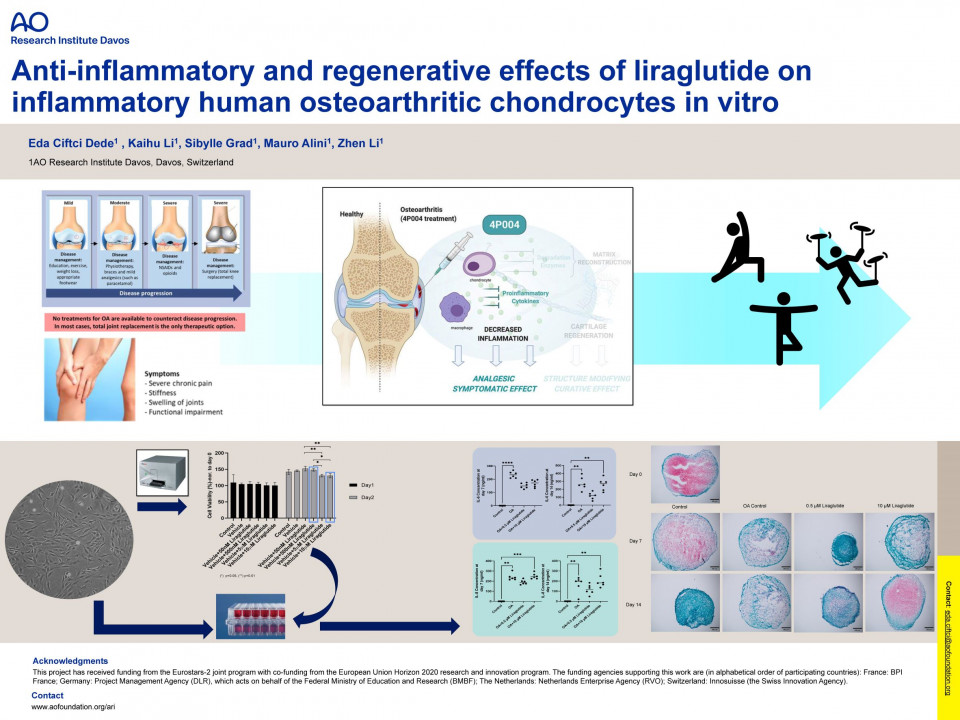Osteoarthritis (OA) is the most common degenerative joint disease and a leading cause of disability worldwide, affecting >40 million people in Europe. With the aging population, OA is predicted to affect 170 million people globally by 2030. Current treatments only relieve OA symptoms. Liraglutide is well known as an anti-diabetic medication that is used to treat type 2 diabetes, and obesity, and to support chronic overweight management. Liraglutide has shown a unique triple effect (anti-inflammation, pain relief, and cartilage regeneration) in inflammatory and post-traumatic OA animal models[1]. The goal of this study is to determine and validate the anti-inflammatory and regenerative effect of liraglutide on human OA cartilage cells (chondrocytes).
In this study, we examined the anti-inflammatory and regenerative effects of liraglutide in a human OA cartilage cell aggregate (pellet) culture model in vitro. Chondrocytes were isolated after informed consent from femoral head cartilage of patients undergoing hip arthroplasty. Firstly, the non-toxic dose range of liraglutide (between 0.05-10 µM) on 2D cultured human OA chondrocytes was determined using a cytotoxicity assay. After that, 2 concentrations of liraglutide (0.5 µM and 10 µM) were selected for testing in the pellet study. Hereby, human OA chondrocytes were plated in a V-bottom 96 well cell culture plate and cultured as pellets for one week in the medium that promotes cartilage tissue formation before the liraglutide treatment. After that, the cartilage pellets were divided into 4 groups: the control group, OA group, OA group + 0.5 µM liraglutide, and OA group + 10 µM liraglutide. The control group was cultured in a basic medium. The OA groups were stimulated with pro-inflammatory factors. The culture medium was refreshed and collected 3 times per week. Pellets were collected at 3-time points (day 0, 7, and 14) for analysis. RNA isolation was performed for gene expression analysis of anabolic, catabolic, and inflammatory proteins. The content of cells and extracellular matrix in the cartilage pellets were also measured. Snap-frozen pellets were sectioned for histological analysis and immunohistochemical staining of important cartilage matrix proteins such as collagen type II. The ongoing analysis will demonstrate if liraglutide has anti-inflammatory and/or regenerative effects on human OA chondrocytes. The results of this study provide further insight into the mechanism of action of this drug and its feasibility for the treatment of OA.
Acknowledgment:
This project has received funding from the Eurostars-2 joint program with co-funding from the European Union Horizon 2020 research and innovation program. The funding agencies supporting this work are (in alphabetical order of participating countries): France: BPI France; Germany: Project Management Agency (DLR), which acts on behalf of the Federal Ministry of Education and Research (BMBF); The Netherlands: Netherlands Enterprise Agency (RVO); Switzerland: Innosuisse (the Swiss Innovation Agency).
[1] Meurot, C., Martin, C., Sudre, L. et al. Liraglutide, a glucagon-like peptide 1 receptor agonist, exerts analgesic, anti-inflammatory and anti-degradative actions in osteoarthritis. Sci Rep 12, 1567 (2022). https://doi.org/10.1038/s41598-022-05323-7
